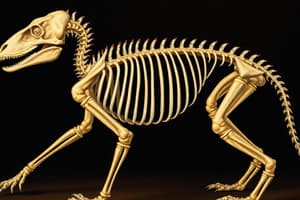Podcast
Questions and Answers
Which of the following phyla is NOT classified among non-chordates?
Which of the following phyla is NOT classified among non-chordates?
- Chordata (correct)
- Echinodermata
- Porifera
- Arthropoda
The heart of chordates is typically located on the dorsal side of the body.
The heart of chordates is typically located on the dorsal side of the body.
False (B)
What is the supporting structure present on the dorsal side of chordates?
What is the supporting structure present on the dorsal side of chordates?
notochord
Chordates are classified under the phylum __________.
Chordates are classified under the phylum __________.
Match the following classes of subphylum Vertebrata with their respective descriptions:
Match the following classes of subphylum Vertebrata with their respective descriptions:
Which type of organization is represented by animals like crabs, frogs, and humans?
Which type of organization is represented by animals like crabs, frogs, and humans?
In asymmetrical bodies, there is an imaginary axis that allows for equal halves.
In asymmetrical bodies, there is an imaginary axis that allows for equal halves.
Name an example of an animal that exhibits organ-system grade organization.
Name an example of an animal that exhibits organ-system grade organization.
All non-symmetrical bodies like some sponges are categorized as __________ bodies.
All non-symmetrical bodies like some sponges are categorized as __________ bodies.
Match the following body organizations with their examples:
Match the following body organizations with their examples:
Flashcards are hidden until you start studying
Study Notes
Non-Chordates
- Nerve cord, if present, is located on the ventral side and is solid and paired.
- Heart, if present, is located on the dorsal side.
- Non-chordates classified into ten phyla:
- Protozoa
- Porifera
- Cnidaria
- Platyhelminthes
- Aschelminthes
- Annelida
- Arthropoda
- Mollusca
- Echinodermata
- Hemichordata
Chordates
- Characterized by a notochord that supports the body.
- Presence of pharyngeal gill-slits or lungs for respiration.
- Dorsal nerve cord is hollow.
- Heart situated on the ventral side.
Phylum Chordata
- All chordates are grouped under Phylum-Chordata.
- Divided into three subphyla:
- Urochordata
- Cephalochordata
- Vertebrata
- Vertebrata further divided into six classes:
- Cyclostomata
- Pisces
- Amphibia
- Reptilia
- Aves
- Mammalia
Body Symmetry
- Animals can be classified based on body symmetry:
- Asymmetrical: No imaginary axis; e.g., sponges.
- Radial Symmetry: Any plane through the central axis yields equal halves; e.g., starfish.
- Bilateral Symmetry: One imaginary axis results in two equal halves; e.g., humans, frogs, fish.
Germ Layers
- Multicellular animals develop germ layers during embryonic development:
- Diploblastic: Two germ layers (ectoderm and endoderm); e.g., Cnidarians.
- Triploblastic: Three germ layers (ectoderm, mesoderm, endoderm); present in most other animals.
Body Cavity (Coelom)
- Coelom is the body cavity between the body wall and internal organs.
- True body cavity (eucoelom) is found in phyla like Annelida and those after it.
Class Characteristics
-
Class Amphibia:
- First group of true terrestrial animals.
- Cold-blooded (poikilotherms).
- Skin is moist and lacks external ears but has a tympanum.
- Examples: Frog, Toad, Salamander.
-
Class Reptilia:
- First true terrestrial animals with scaly, dry skin.
- Cold-blooded and cannot lift their body off the ground.
- Neck is present between head and trunk.
- Examples: Tortoise, Lizard, Snake.
-
Class Aves:
- Fully adapted for aerial life; warm-blooded (homeotherms).
- Body shape minimizes air resistance.
- Forelimbs modified into wings with feathers for exoskeleton.
- Examples: Peacock, Parrot, Pigeon.
-
Class Mammalia:
- Presence of mammary glands.
- Warm-blooded with a body divided into head, neck, trunk, and tail.
- Digits may have nails, claws, or hooves, exoskeleton in the form of hair or fur.
- Examples: Elephant, Human, Dolphin, Bat.
Additional Notes
- Animals like gharial and crocodile are reptiles, despite their semi-aquatic lifestyle.
- Whales and walruses, living in the ocean, belong to the class Mammalia.
- Importance of responsible animal study highlighted, warning against harm during observations.
Studying That Suits You
Use AI to generate personalized quizzes and flashcards to suit your learning preferences.




